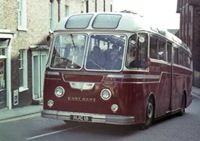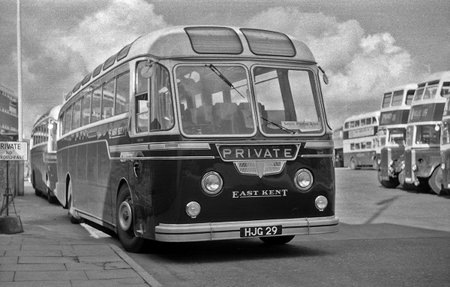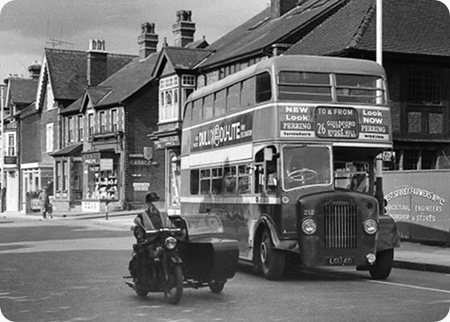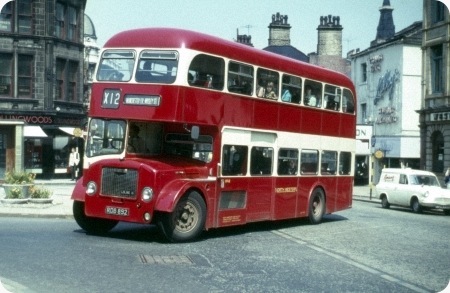East Kent – Dennis Lancet UF – HJG 18
East Kent Road Car Co Ltd
1954
Dennis Lancet UF
Duple C41C
This picture of East Kent HJG 18, a Dennis Lancet UF with Duple C41C body, was taken in Rye in 1967. East Kent, like fellow BET operator Aldershot & District, was a great fan of the pre war and post war vertical engined Dennis Lancet, and, in 1954, took delivery of 30 of the underfloor engined Lancet UF. This was the largest single order for this model, of which only 71 examples were built between 1953 and 1961. Aldershot and District tried out the Strachan bodied Lancet UF demonstrator, but bought none, though it continued to run the unique Dennis Dominant for fifteen years. One can now only speculate as to the reasons for the commercial non acceptance of the Lancet UF. Certainly reliability could not have been a problem. East Kent kept their UFs for 14 to 17 years. The low driving position was received with suspicion in certain quarters back in 1953, yet now it is a standard feature on touring coaches. The power plant was a horizontal version of the advanced, smooth running 24 valve 7.58 litre O6 engine fitted in the Lancet III, though the maximum engine speed was raised to 2000 rpm to give 110 bhp. Some later examples for Glenton Tours had the 120 bhp 8 litre version of this engine. The gearbox was the standard Dennis five speed constant mesh unit with preselective overdrive, but revised to operate in the conventional sequence with lowest gears to the left and highest to the right – the vertical engined Lancet gearbox worked the "wrong way round" from right to left. Possibly a major factor in the low uptake of the Lancet UF was the employment of a fully hydraulic braking system, which has never been popular with engineers outside of London Transport and Midland Red. Hydraulic fluid is costly, whereas air for air pressure or vacuum brakes is free. It is noteworthy that the initial version of the AEC Reliance that came to reign supreme with both East Kent and Aldershot & District had a straightforward, direct top (not overdrive) five speed synchromesh gearbox and vacuum brakes, though their wet liner engines were certainly not trouble free.
Photograph and Copy contributed by Roger Cox
———
03/07/11 – 19:59
I’m ambivalent about Dennis. I don’t have much time for modern Dennis Dust-carts – although there are some great might have beens that never followed through their promise with reliable service (especially the Falcon V and R Series). The R Series is actually one of the best coaches I’ve ever driven – including Setras, ZF Reliances and REs.
Having said that, the Loline (albeit a Lodekka clone) was a superb bus. East Kent and A & D weren’t the only operators to take to Dennis Lancets in a big way – so did Tracky – and Glenton gave theirs a full service life. None of these would have willingly run rubbish.
Dennis always seem, even with their current dominance, to fall short of the quality of the late lamented AEC, Bristol and Leyland.
David Oldfield
———
06/07/11 – 07:24
The Dennis UF was tried on A&D as you say and it was used on a number of routes however it was not "hitting the spot" with A&D who were already looking at AEC Reliance and being lighter and more cost effective. The UF was a much heavier vehicle. As we see from history, they went the AEC route in the end. There was also a problem with the UF overheating on hilly routes.
Hope this adds a bit of an update for you.
Doug Sneddon
———
06/07/11 – 13:50
The Lancet UF was a bit heavier than the early vacuum braked AEC Reliance, but not by much. The chassis weight of the Dennis was 3ton 17cwt, against 3ton 14cwt for the AEC. I hadn’t before heard of overheating problems with the Lancet, but the type was pretty rare and information about its performance in service is similarly scarce. I suspect, also, that operators were suspicious of the low driving position, especially for bus work, and also put off by the full hydraulic braking system and the double reduction rear axle. The AEC, with its single reduction rear axle, vacuum brakes and direct top synchromesh gearbox would have suggested a simpler vehicle to maintain, as well as being easier to drive. I am not a great AEC fan (the Regent V with conventional transmission was a somewhat primitive and noisy vehicle to drive, and not a patch on the Regent III), but the AEC five speed gearbox in the Reliance was a delight to use. The AEC wet liner engines were certainly not trouble free, though.
Roger Cox
———
08/07/11 – 06:16
I have to amend my comment under the picture at the top of this entry. The Dennis five speed gearbox, as Ian Thompson has correctly pointed out elsewhere, was a sliding pinion (i.e."crash") gearbox, not a constant mesh unit. With the engine and gearbox remote from the driver, smooth gear changing would not have been easy to accomplish, and the Reliance would have scored over the Dennis on this point also.
Roger Cox
———
09/07/11 – 07:07
With East Kent they were always referred to as ‘Spaceships’ for fairly obvious reasons. I must be one of the few who has conducted on one – an urgent relief to a Dover-Ramsgate journey with nothing else available (1966, I think). It caused a bit of confusion but was welcomed by passengers left behind by the service car, especially as it had started raining.
Lew Finnis
———
10/07/11 – 07:39
I cannot claim a great pedigree of Lancet UF driving (but so rare; who can?) However the one I have driven was a "Chinese" gearbox with low gears on the right hand side of the gate. I wonder if the reference to a normalised change is confused with the optional Meadows gearbox, particularly found in some of the later Glenton fleet. To continue and hopefully elaborate on the gearbox. It is very true to say the large and heavy box was very old fashioned compared with the AEC 5 speed. Yes, the lower gears were sliding mesh (4th of course being direct so strictly speaking no gears involved). But 5th was constant mesh engaged by preselected dog clutches – but here’s the thing, even though constant mesh, the gears were straight cut and therefore tended to be noisy (or according to taste, musical) even at cruising speed.
Nick Webster
———
10/07/11 – 07:41
An interesting experience, Lew, especially when trying to get the fares from the passengers sitting in the front nearside seats low down beside the driver. What was the opinion among the East Kent driving staff of these Lancet UF "Spaceships"? The East Kent fleet of 30 was the largest order ever placed for the type.
Roger Cox
———
11/07/11 – 07:41
Thanks for your comments, Nick, which give us a valuable insight into the characteristics of the Lancet UF. The vertical engined Lancet and the Lance double deckers certainly had "right to left" upward selection of the gears – why on earth did Dennis persevere with this arrangement so long after the rest of the industry, including Guy (GS type excepted), had standardised on "left to right"? – but my understanding that the Lancet UF gearbox worked in the logical pattern comes from the "Modern Transport" magazine road test of the type in March 1954, which refers to the selection of overdrive being accomplished "by moving the main gear lever from the direct drive position to the right against a spring and then forward". I certainly wasn’t aware that the later Glenton coaches, presumably the 8 litre version, had Meadows gearboxes. I recall from somewhere that the Meadows gearbox had a "Chinese" gear selection layout as well. Whilst on that subject, David Brown gearboxes also had strange selector layouts, as anyone who has driven a Bristol SC4LK will know.The Clark/Turner gearbox in the Bedford VAL was another strange creature. No doubt there were others.
Dennis appeared to lose its way somewhat in the immediate post war period. The Lancet III was a quite successful type, and the lighter goods vehicles also sold well until undercut and overtaken by the cheaper lightweights from Bedford and Ford. In part, the firm suffered from the sudden loss of both of the Dennis brothers within three months in 1938 – Raymond Dennis was only 59 years of age, and John was 67 – and the post war heavy lorry business was dominated by British Road Services which placed the bulk of its orders with Leyland, AEC and Bristol. The advanced O6 engine soon proved to be too small at 7.58 litres, and later 8 litres, for the heavier demands of the late 1940s onwards. Had the firm upgraded the earlier O4 from four to six cylinders it would have had a 9.8 litre engine of some 125 bhp to take on AEC and Leyland. Instead, Dennis developed six cylinder engines of 5.0 and 5.5 litre sizes, that must have barely recovered their development costs as the mass producers increasingly captured the lighter end of the market. The survival and success of Dennis today, albeit in a decidedly different guise, is one of the surprises of our time.
Roger Cox
———
11/07/11 – 10:35
Although various Gardner, Leyland and Rolls Royce power plants were used, British Road Services was BTC and therefore was a (new) BRISTOL operator. [The only period when Bristol was a serious HGV manufacturer.] It is true that they operated other makes, including AEC, but for the most part these were vehicles taken over from the small independents who were nationalised. Those of you who have read the excellent Barber/Davies Wallace Arnold books will know that the associated Barr Haulage business was nationalised and became part of BRS.
David Oldfield
———
12/07/11 – 05:44
Strange gearboxes I have known.
I once had a ride on one of Brown’s (Donington Wood) Sentinels. The driver said it had a Meadows box. The arrangement was not only switched right-to-left but also top to bottom. This probably meant that the gearbox was of standard layout internally but there was an extra fulcrum in the linkage. This was after all one of the very first underfloor-engined vehicles.
F & H Dean of Newton Heath was a subsidiary of Maynes (Manchester) and ran a fleet of Bedford coaches. As a teenager I travelled on two of the SBs, one with a Bedford 4-speed box and one with the weird Clark/Turner 5-speed unit mentioned by Roger. But both were switched round right-to-left, with the low gears on the right and the high on the left.
Finally I was involved in the failed attempt to preserve a Foden PVD6 of Garelochhead Coaches. When we went to collect it we found it had an unmistakeable Foden gearbox – i.e. with super-low and super-reverse – but again switched around right to left. We wrote to Foden, who said they had never built a gearbox like that and it must have been rebuilt by the operator. We wrote to the operator, who said it had been like that from new.
All sorts of stuff goes on that nobody knows about!
Peter Williamson
———
13/07/11 – 07:24
Early utility Guys delivered to London Transport (and no doubt other operators), had the left and right gates reversed. Guy later changed the gate to the conventional one. To avoid driver confusion, LPTB cut a couple of inches off the top of the (I think) non-conventional gear levers. It seemed to work, although you’d soon learn that pulling away in third was silly!
Off-topic I know, but it’s good that mention’s been made that Bristol built HGV’s for British Road Services. Here is an excellent example of their product: at this link
Chris Hebbron
———
18/07/11 – 11:42
Most interesting to read Nick Webster and Roger Cox’s comments on Dennis Lancet UF gearbox variants. I certainly had no idea of the option of a Meadows box, which was perhaps chosen as being more manageable for new drivers than Dennis’s own excellent but unusual product. I’ve got a "Driver’s Handbook for Lancet U/F Diesel" publication 320c (surely they never offered a petrol version?!) which illustrates the gate with Reverse to the right and back and with Overdrive to the left and forward—exactly as on the halfcab Lancets. But the table of ratios shows 3rd as 1.55:1, whereas in the postwar Lance and most?/all? postwar Lancet half cabs 3rd was 1.66:1. I’ve also got a note, copied from a prewar magazine, that the 1936 O4-engined Lancet could be had with either of the following ratios:
0.69:1, 1.00:1, 1.55:1, 2.74:1, 4.54:1 and R 5.84:1.
0.69:1, 1.00:1, 1.55:1, 2.94:1, 5.18:1 and R 6.66:1.
That second option gives a good wide spread, but the ratio gap between 3rd and 2nd looks a bit daunting!
All this choice seems to fall in line with Dennis’s willingness to give customers what they wanted—not that such generosity always did the company all the good it should have done!
Was the choice of a double-reduction rear axle for the U/F partly aimed at providing as low and uncluttered a floor as possible? The bevel crown-wheel/pinion ratio is less than 1.5:1, with a further reduction of over 4:1 in the hub. This way the diff housing is much smaller than with the usual CW/P ratio of about 5:1. The drawing does not show the housing as being offset to one side. Again, a bewildering variety of alternative overall ratios is given.
Stuck onto page FRA1 of the "Lancet U/F Instruction Book" publication 373c is a note saying:
"The axle described in this section is the F.101-2 fire engine type used with the all indirect drive gearbox. If a conventional gearbox is fitted to a chassis such as the Lancet U.F. then the spiral bevel wheel is mounted on the other side of the differential unit case so that the difference in input shaft rotation is accommodated. In other respects the axles are the same."
Visions of a bus with 5 reverse gears and only a crawler for forward motion…
Ian Thompson
———
18/07/11 – 22:59
Ian, that second gearbox option on the O4 Lancet would have given it Alpine hill climbing ability, albeit in reverse.
I have to admit a soft spot for Dennis (had anyone noticed?). It was always a relatively small firm, but its engineering was of a very high order. The Lancet III with its advanced 24 valve engine proved to be an outstandingly reliable power plant, and numerous small, and some not so small, coach companies held this model in high esteem. According to the book "Dennis-100 Years of Innovation" by Stewart J. Brown, Dennis’s best year for sales before the Hestair takeover was in 1949 when it sold 1096 buses and lorries, and it is probable that the Lancet III formed a major part of that total. It was sad that the UF version didn’t win the same level of support, and the company could surely have amended the specification to accord with the clearly emerging engineering preferences of the bus industry. The pointer was the outstanding success of the AEC Reliance, and one can only wonder why Dennis did not try to emulate as many features as possible of that top selling model. By 1958, Dennis had a new five speed constant mesh gearbox in the Loline, which also had air brakes. Why wasn’t the Lancet UF re-engineered to accept these features? Similarly. a single reduction rear axle option and a revised chassis front end without the "drop" could surely have been offered at modest cost. Instead, Dennis pursued several lines of development that ultimately led nowhere, the Jaguar engined low floor front wheel drive ambulance being the extreme example. One should be grateful that the company is still with us, though it is now a very different creature from the Dennis of fond memory.
Roger Cox
———
19/07/11 – 06:56
After about 1950 the market for new buses and coaches contracted suddenly, making it impossible for all of the manufacturers who had been successful during the shortages of the early postwar years to continue to thrive in the same way. There just wasn’t room for them all in the marketplace. The major market for the Lancet UF would have been the BET operators, who would have been instructed not to buy it. Little point in investing in further development of a product which could only be sold to independents.
Therefore I don’t believe the apparent decline of Dennis in the PSV market in the 1950s should be seen as a failure. Dennis were doing what they wanted to do, and what they did best, which was niche marketing. For years they didn’t waste any effort on the PSV market unless there was a niche to fill. Even the Dart would have been seen as a niche product when it was launched, but changes in the marketplace turned it, and Dennis, into something else.
Peter Williamson
———
23/07/11 – 08:38
Dennis had several BET company customers for the J3/J10 Lancet in the early post war period, and East Kent did initially buy the UF version. Aldershot and District, North Western and City of Oxford all bought the Loline, so that, whilst it is true that the BET group were AEC/Leyland orientated, there is no evidence that Dennis could not have sold a re-engineered Lancet UF to companies that wanted it. Before the advent of the Fleetline, Daimler was almost exclusively a supplier to municipal fleets, but the Fleetline soon found a place in the BET order books. Dennis’s emergence in niche marketing didn’t really happen until the Hestair takeover and the abandonment by the company of hgv production (dustcarts excepted). Much of this was a means of testing the psv market to find a new place for the company in a market then dominated almost exclusively by Leyland, whose arrogant "take or leave it" attitude under Donald Stokes generated a groundswell of resentment in the bus operating industry (including NBC!). With the development of the Javelin and the Dart, Dennis found mass markets, and the small production runs of almost bespoke models ceased.
Roger Cox
———
25/07/11 – 08:57
Sorry, what I meant by niche marketing (which may not be quite the right term) was not small-volume as opposed to large, but addressing a gap in the market as opposed to competing head-on with similar products.
Peter Williamson
———
26/07/11 – 07:33
Regarding the BET Group, something I’ve just remembered, and which I’m sure Dennis would have been well aware of, is that Atkinson developed the Alpha single-decker at the specific request of North Western, who were then ordered to buy Leylands instead. The NWRC Chief Engineer, who had overseen the development, resigned as a result. I don’t think this BET policy was due to engineering preference so much as the availability of bulk discounts for group purchases.
Peter Williamson
———
04/08/11 – 21:35
As far as I can recall, the drivers had no great gripes about them, other than the low driving position. From what I remember, they had a good turn of speed. They certainly soldiered on for a long time on the Port shuttles for Sealink and Seaspeed foot passengers after they had been taken out of front-line service.
Lew Finnis
———
28/10/11 – 14:12
My uncle worked as a driver at East Kent’s Herne Bay garage in the 1940’s – 1950’s, driving Leyland Tigers (TS8) and he said that he was not fond of the Lancet UF’s due mostly to the gearbox, and it’s remote location. He reckoned there was only one driver at Herne Bay that could actually drive them properly on tours work. He was also quite scathing about the Morris Commercial Imperial deckers based at Herne Bay – but that’s another story.
Mike
———
17/12/11 – 16:33
I was looking at your web site re bus tickets and buses as I am writing a small piece for our village news round. As a boy I remember a coach similar to to the one described above. It had a double seat adjacent to the driver at the front and the door was situated along the side in the middle. I remember the reg as being HAY 111 and was owned I believe by Birchers or Ridgeway and Windridge and operated under the name of Victory Coaches in Ibstock Leicestershire approx late 50s any use or can you confirm anything. I do remember other firms in the area described in the web site Brown Blue and Gibsons, others in our area were Rudins, Blockleys
Peter Stirland
———
18/12/11 – 07:33
HAY 111 was an AEC Regal IV which had Gurney Nutting C41C bodywork. It was new in 1951 to Windridge, Sons & Riley t/a Victory of Ibstock. When they sold out to Browns Blue in 1958, this vehicle was included in the sale and served with BB until the end of their operations in 1963. As Midland Red didn’t keep any of the vehicles, it passed to Yuille of West Hartlepool but I’m afraid I know nothing of Yuille.
Chris Barker
———
 Vehicle reminder shot for this posting
Vehicle reminder shot for this posting
———
10/09/12 – 07:15
Mention has been made about the turn of speed attributed to the East Kent Dennis Lancet UF. Based on examination of what is believed to be the last remaining example (just about!) I can reveal that this one at least is fitted with a higher ratio back axle than standard and the later and larger 8 litre engine. The axle appears original and the engine has tags indicating that it was fitted by East Kent, rather than some subsequent owner.
Nick Webster
———
11/09/12 – 07:27
Here is another of these fine East Kent Lancet UFs. HJG 29 is seen pictured in Canterbury Bus Station in 1961. Another vehicle of this class is parked behind it. This handsome 1954 style of Duple body compares very favourably with the bulbous abomination fitted to 1961 Black and White Reliance 8222 AD. It was somewhere about 1960 that Duple began to lose its way in my opinion.
Roger Cox
Quick links to the - Comments Page - Contact Page - Home Page





